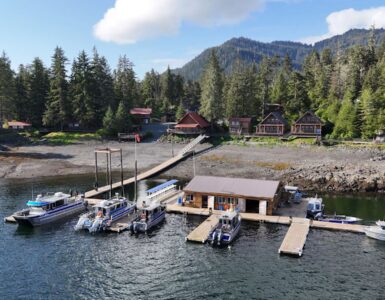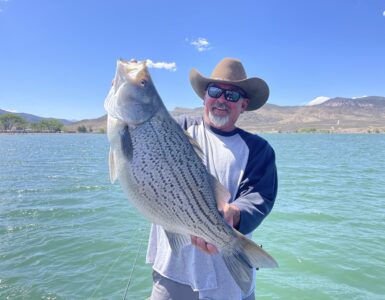Thanks for tuning into KSL Outdoors, I’m Adam Eakle and this is my daughter Taylor Eakle and we are just south of Moab over on the Lasal Range and we are headed into a bear den. Something you’ve never done before. Learning it in Wildlife Biology and perfect timing. Yeah, good time to go check it out and you know biologists are always on the lookout, always studying the bears down and across the state, we are hoping to see some cubs.
There you go.
We are going to head up here and check on two bears that we’ve got collared up here. They are both females.
An interesting thing about this bear, the first one we are going to is that it actually won one of your snapshots of the week. It was two summers ago. There was a bear sitting in a water trough looking up at the mountains. Oh yeah, he was taking a bath. Yup.
In a hot tub, yup, yup. So that should be this first bear.
We are looking at these bear dens as part of a study where we look at production from year to year. See how many cubs that they have and we also look at survival. see if they have yearling cubs in there with them.
Both of the adult bears we are going to show you tonight were trapped near a residential area. Biologists relocated them some forty miles away. Both have returned, near to where they were trapped, and so far both have stayed out of trouble.
She’s just on the other side of the drainage right here. We’ll have everybody else stay up here and just go get done what we need to and bring them in.
The den is right here under that tree. Got a hole in the dirt. I can hear the cubs up there.
I’ve seen quite a few bear dens, but nothing like this one. Usually they are under a log, cliff, or boulder. This sow dug her den under the roots of a cedar tree. She’s hibernating, but….
We are going to have to dart her. She’s awake.
Probably about a two hundred fifty pound bear she looked like. She’s a bigger bear.
Based on her estimated weight biologist will now, mix up a cocktail of drugs to knock her out.
So it’s ketamine and xylazine, a mixture of that. The keyomine pretty much knocks them out. The Xylozene just makes it easy on them so they are not so stressed out.
Ok.
The drugs are loaded into a dart that will be shot by an air gun into the bear. Dustin drew the short straw and will be diving into the den, to go face to face with this groggy bear.
Can you hear that. That sound is called clacking or jaw popping. The sow is protecting her cubs and letting Dustin know, he is an unwelcome guest in her den.
She’s alert in there. So we put those back packs in front of the den just to keep her in there more so. Keep the stress levels down on her so.
Try to be as quiet as we can.
Now we wait about 7 minutes, wait for the drugs to take effect on her. Then we’ll go in and see what she’s got for cubs. You could hear cubs though? You could hear cubs yea.
Any idea on how old this bear is? Last year we were guessing that she was about four years old.
Alright i think she might be asleep, her head is down. Go ahead and pull those off.
Bear, hey, hey!
The sow is asleep, now to see how many babies she had.
I can hear them, but I can’t see them. I think she’s kind of covering them up.
Their eyes are still closed, so they are probably three weeks old.
I only see the one. Did you see two? I didn’t see it, it just sounded like it.
Oh I see it.
Oh this one is a screamer.
The biologists can now work on the sow, while our crew babysit the cubs.
So we want to reduce the stress on these as much as possible. So leaving the sow in the den here so we don’t have to handle her very much, move her around. That’s what we are after.
Guy will now cut the old radio collar off.
out with the old, in with the new.
and put a new one on. Biologists will also give the sow a quick once over, and put some vicks vapor rub on her nose to mask the smell of our presence.
She’ll be groggy for awhile and then she’ll come back through. I’ve seen them come back and they’re just fine. Go back to nursing and taking care of their little ones.
Keep it warm Taylor. Put your coat over it.
It’s little claws are like so cute.
We’ll have more with the bears in a moment, plus we’ll visit another den, but first let’s test your bear knowledge in tonight’s Burt Brothers quiz question.
Bears are the youngest of the carnivore families, having arisen from doglike ancestors some 55 million to 38 million years ago. Modern bears first appeared in Eurasia around 5 million years ago. These bears were relatively small animals, but some types eventually grew quite large. Our Burt Brothers quiz question tonight is…What is the largest bear to ever roam North America? The answer when KSL Outdoors, powered by Ford returns to the Lasals.
Welcome back to the Lasal Mountains. More bears in a moment, but first tonight’s answer to our Burt Brothers quiz question. and our question is….What is the largest bear to ever roam North America? and here’s the answer. The extinct, giant short-faced bear stood six feet tall at the shoulders, and on two feet, he stood nearly twelve feet tall. The short-faced bear became extinct about eleven thousand years ago. Many scientists believe this bear could run nearly 40 miles per hour despite weighing over 1500 pounds and was the largest carnivorous land mammal that ever lived in North America.
You know sportsmen in general we want to see the control of predators. But it’s really cool to see the control of predators in this sense. This is an amazing experience for sure. and the Lasals has a super healthy bear population, we know that so it’s pretty neat to see them up close and personal in a different way.
The best data we have is based on our harvest, what our sportsmen are out. When they harvest bears we can learn a lot about a bear population by what is harvested. The proportion of females in the population, the age of the bears harvested and things like that.
Yeah I’d say our bear population is steadily growing in the last couple of years. We’ve been able to increase opportunity for hunting because of it. Yeah, they are solid.
She looks good.
The biologists are done working on mom and it’s time to put the rug rats back into the den. The entire process took about 30 minutes, the sow will awake in about a half an hour.
You can see they are already trying to get up there and nurse.
They then cover the entrance to the den with sticks and brush.
There we go. That looks pretty good.
The last thing is they attach a trail camera near the entrance to gather more information after we’ve left.
We see some things we didn’t know before. Like? the cubs we wondered how cubs learn to shred material and bring it into the den make a nest inside the den. We found that females in the spring they’ll take the cubs out and they’ll teach them. They’ll actually go and shred bark off trees and drag it back in. Pretty soon you watch and the cubs will start doing it.
There’s just enough time to look for one more collared bear.
Yeah there are two that have denned in this canyon. Another female and this one is likely to have a yearling with her.
The last one you pretty much knew where it was, and these ones? This one she’s got a radio collar so we’ll probably have to use telemetry to locate her den.
It takes a few minutes but biologists pin point the den on one of the steepest cliff faces in the canyon.
It goes about 20 feet back. Yeah she’s got a yearling in there to.
They then tranquilize both bears, replace this sows collar and give the yearling an ear tag.
When would you expect these bears to start coming out of their den? They’ll start coming out in March. They actually go in and out almost daily. they’ll go out and wander around a little bit.
That lasts three weeks to a month and then they disappear.
does it ever get old? No these days never get old. I’m getting old, but
What do you think of that? It’s pretty cool. Eye’s aren’t even open huh? Hey our biologists do a great job here in Utah, managing our wildlife. Especially the bears, not just the deer and elk, but the bears, the cougars everything as well. What a cute little guy.
Welcome back to KSL Outdoors, I’m Adam Eakle. Well for our next adventure we’ve moved to Evanston Wyoming, the hub of adventure for Southwestern Wyoming and even into the High Unitahs. You know some of the best sled dog racers are in town for the Eukanuba Stage Stop Dog Sled Race and everybody is chasing six time champion Blayne “Buddy” Streeper.
Three. Two. One. There he goes, Bruce Magnusson is on the trail.
Stage stop race is similar to Tour De France.
The clock is running for Jerry Bath, good luck Jerry.
So each day we run a different trail in a different community.
averaging about 40 miles. We accrue time so there is a cumulative overall time. And then there is also the daily times.
Traveling through 8 towns, and four states, the Eukanuba Stage Stop Dog Sled Race is the only race of it’s kind in the world. There are thirteen teams from Alaska, Canada, Michigan, Minnesota, even Lander, Wyoming. Today is the last stage of the race. The mushers say, usually by this time, the dogs feet are a bit sore, their muscles a bit stiff, but you wouldn’t know it by the excitement in their voices.
This is a prestigious event. This is our Super Bowl of the year.
Buddy has won this event, six times. Including five of the last six years. He entered todays final leg with a huge 24 minute lead.
The clock is running for Bud Streeper. He’s got 41 miles to hang onto his lead.
I just wanted to have a good clean run, keep all the dogs happy and safe throughout the technical portions of this trail. And uh, once we hit that point, it was behind us, then I let the dogs run at their natural ability.
Today’s climb started in Wyoming where teams then had to conquer the 10,000 foot peaks of the high Uinta Mountains. That didn’t deter Buddy’s team from claiming the day’s fastest time, and the overall shortest cumulalive time.
Buddy won the eight day event with thirty one minutes to spare.
Good job Al Gorak.
It was great to race with all of these competitors. We have the best vets, the best race judges, best trails, It was a great event.
Even though this it’s not called the World Championship, this is the big one for us and the dogs just did amazingly and that’s the most important thing is how the dogs did I’m very happy with it.
Coming off the trail, Alex Stegmann.
Streeper kennels had two teams in the race, and not only did Buddy win, his team member Alex Stegmann took second place overall.
Every musher has their own blueprint on how they want to do things. But I think because we go into every single detail, how we run our dogs, how we go downhills, how we do up hills, how we do our own feeding. No one can beat us at that.
As far as purses are concerned we are the second largest sled dog race in the world. Second only to? The Iditarod.
Between cash and prizes, the purse is well over one hundred and ninety five thousand dollars. Every team takes home a share. But the real winners here are the communities that support this unique event.
They make their money by winning the races and eventually having their kennels and selling their dogs. So it’s a big deal for them.
They like to come up and talk to you ask how you are doing, give you a hand shake. Get to know you. I love Wyoming, I love Utah, the lower 48 in general, especially the northern part.
And Alex’s love of the US should only get stronger, as his second place finish should buy his team a lot of gas and dog food.
It buys quite a bit.
Time now to head down a different trail, in tonight’s Utah Field Guide.
It’s one sure sign that ol’ man winter is on his way out.
it’s the sound of lesser snow geese and their annual congregation in the area around Delta. Each February thousands of these beautiful white birds use the fields and waters between the Clear Lake Wildlife Management Area and the town of Delta as a rest stop on their Northern migration.
These geese spend the winter in the Imperial Valley in California. While there, they feed and prepare for their 3000 mile trip to Canada’s Northwest Territories. Around the second week in February they begin to arrive around Delta. It’s a wildlife sight unparalleled in Utah and you are invited to take part in the spectacle.
On February 26th and 27th, the town of delta rolls out the red carpet for these white birds with their annual Snow Goose festival. Utah Division of Wildlife biologists will be on hand with scopes and binoculars, as well as expertise to find the birds and answer any questions.
For information on the festival, check out their website at DeltaGooseFestival.com.
Boy great weather today for the sled dog race here just outside of Evanston. Great weather for ice fishing, snowmobiling, even cross country skiing. Hey let’s find out that recreation forecast for your next outdoor adventure by turning it over to the guys and gals in the weather department.







Add comment